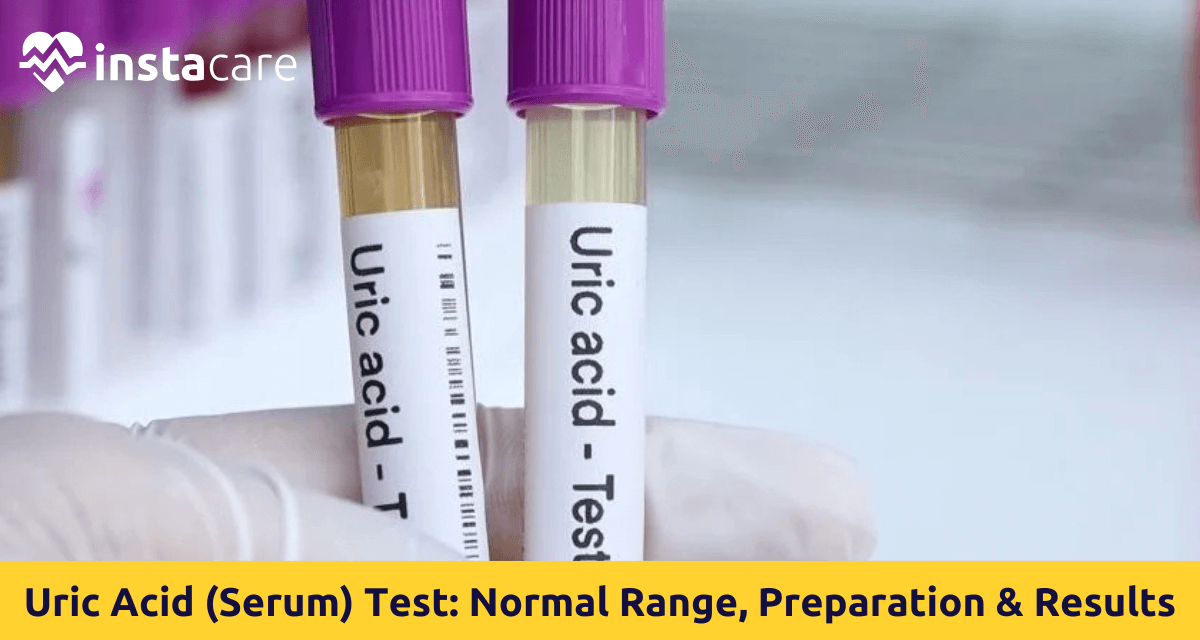Blood uric acid is tested to see how much uric acid your blood contains. Uric acid is formed as a byproduct when your body breaks down purines, which are found in some foods as well as in your body's own manufacturing. Uric acid is usually dissolved in the blood and eliminated via the urine. Yet in excess levels, or hyperuricemia, they become the cause of diseases such as gout, kidney stones, and renal impairment. The blood test for uric acid is extremely important in disease diagnosis and treatment, and therefore it is a valuable test to assess the functioning of the kidneys as well as uric acid metabolism.
What is a Uric Acid Test?
This is a lab test that screens uric acid in an effort to assist in determining how your body breaks down and eliminates it. Cells break down and uracil from foods with high purine content (seafood, red meat) form uric acid. It is meant to be eliminated by the kidneys through urine, but something gets in its way and uric acid accumulates.
The test is done for the diagnosis of Low uric acid levels abnormality, and the test helps in diagnosing gout, kidney disease, and metabolic disorders. The test is ordered periodically if you have
arthritis, kidney injury, or as a part of routine health check-up.
Why the Uric Acid Test is Ordered?
Doctors order the test because of the reasons mentioned below:
- Diagnosis of gout: For diagnosis of elevated Uric acid test for gout that causes inflammation and pain in the joints.
- Screening for hyperuricemia: Detect increased levels of uric acid before they cause symptoms and complications.
- Kidney stones: Track uric acid crystal formation to create stones and cause urine obstruction.
- Test kidney function: Abnormal shows compromised Kidney function and uric acid to filter.
- Risk for metabolic syndrome: Elevated levels of uric acid are more likely to be linked with obesity, diabetes, and cardiovascular disease.
- Monitor drugs: Some drugs affect levels of uric acid and need to be adjusted in dosage.
How to Prepare for Uric Acid Test?
Uric acid test preparation for Best test result:
- Fasting: Fast for 8–12 hours before the test, water is permitted.
- Do not eat purine foods: Avoid eating red meat, organ meat, seafood, beer, and liquor for 24 hours.
- Disclose medications: Correct diagnosis allows for the modification of treatment and lifestyle alteration to avoid further disease progression.
- Report drugs: Tell your doctor about drugs such as diuretics or aspirin that influence uric acid. They can recommend stopping particular drugs.
- Hydrate normally: Drink water but not excessive amounts beforehand.
- No heavy exercise: Severe exercise 24 hours beforehand will raise uric acid temporarily.
- Relax: Stress will influence lab work.
By doing the above, it will reveal your actual uric acid level.
Uric Acid Test Procedure
The procedure is brief and simple:
- You will be told to sit down and extend your arm.
- The antiseptic swab is placed on the inner elbow to prevent infection.
- The tourniquet (rubber band) is put further up on your top arm to get veins that are filled with blood so they will be visible and can be found easily.
- A small, sterile needle is inserted into a vein, often in the elbow area, to draw in a small amount of blood.
- The blood is drawn into a syringe or vial on the needle.
- The needle is withdrawn slowly when an ample amount of blood has been drawn.
- The area is pressed gently with a gauze or cotton ball to make sure that no bleeding is caused.
- A small Band-Aid can be applied over the area to conceal it.
- The test is performed on blood in the laboratory.
It is only a few minutes and is done with little pain.
What to Do Once the Uric Acid Test Has Been Completed?
After the test:
- Resume normal activity immediately.
- There may develop some minor stinging or bruising at the puncture site and lasts for a day or two.
- No minor swelling or bleeding which will from time to time occur.
- No medication after the test need be taken.
- Longstanding pain, swelling, or infection should be reported to your doctor.
Reading Uric Acid Test Results
Normal uric acid range is in mg/dL.
- Men: 3.4 to 7.0 mg/dL
- Women: 2.4 to 6.0 mg/dL
The uric acid overproduction or renal insufficiency of uric acid in the excretion of uric acid leads to Uric acid kidney stones, gout, and renal damage. The causes can be due to diet, medication, nephritis, or dehydration.
Hypouricemia is an uncommon state and secondary to uncommon inherited disorders or renal insufficiency.
If there is abnormality in Uric acid test results interpretation, then the physicians shall write:
- Restaging by reperforming the test.
- 24-hour uric acid excretion in urine to determine the manner in which the kidneys eliminate it.
- Kidney function tests (creatinine, BUN).
- Imaging in suspected renal stone.
- High uric acid symptoms and results of other testing to make an overall impression.
Diseases Detected by Uric Acid Test
The test is useful in diagnosis and follow-up of:
- Gout: Crystals of uric acid deposited leading to joint pain.
- Uric acid stones of kidney: Crystals precipitation leading to urinary tract stone.
- Chronic kidney disease: Kidney dysfunction in filtration leading to hyperuricemia.
- Metabolic syndrome: Frequently associated with obesity, hyperuricemia, and diabetes.
- Lesch-Nyhan syndrome: Congenital rare disease with hyperuricemia.
- Tumor lysis syndrome: Transient acute hyperuricemia as a complication of cancer treatment.
Treatment is easy with daily follow-up with life modification.
Uric Acid Serum Test vs Urine Test
The serum uric acid test measures the level of uric acid in your blood. It is a challenge to the overall balance between how much uric acid your body makes and how much your kidneys can eliminate. It is the initial and most frequent Gout diagnosis test and hyperuricemia (high uric acid) tests. High levels of serum uric acid may be indicative of disease such as gout, kidney disease, or metabolic syndrome.
The test for urine uric acid, however, is to discharge the whole 24-hour yield of urine to be able to figure out the quantity of uric acid which is being discarded by the kidneys. The result of the test will show whether or not excessive blood uric acid levels are caused by excess uric acid produced by the body or not but rather as the defective discardment of the uric acid by the kidneys.
In combination, serum and urine uric acid test gives the complete image of uric acid metabolism and thus allows doctors to diagnose and treat more specifically by evaluation of production and excretion processes.
Cost of Uric Acid Test in Pakistan
Cost of uric acid test in Pakistan is around PKR 800 to PKR 2,500. Costs vary based on the city, reputation of lab, and technology. Urban locations like Karachi, Lahore, and Islamabad are pricier because they have newer machines and faster reports. At some labs, it costs less to get the uric acid test and another similar blood test done at the same time. Lab prices are compared and determine if your health pays for the test to save money out-of-pocket.
Book lab tests from the
best-certified labs in Lahore, Karachi, Islamabad, and all major cities of Pakistan through
InstaCare, and get a discount of up to 35%. For assistance, call our helpline at 03171777509 to find the right lab test for your health needs.

